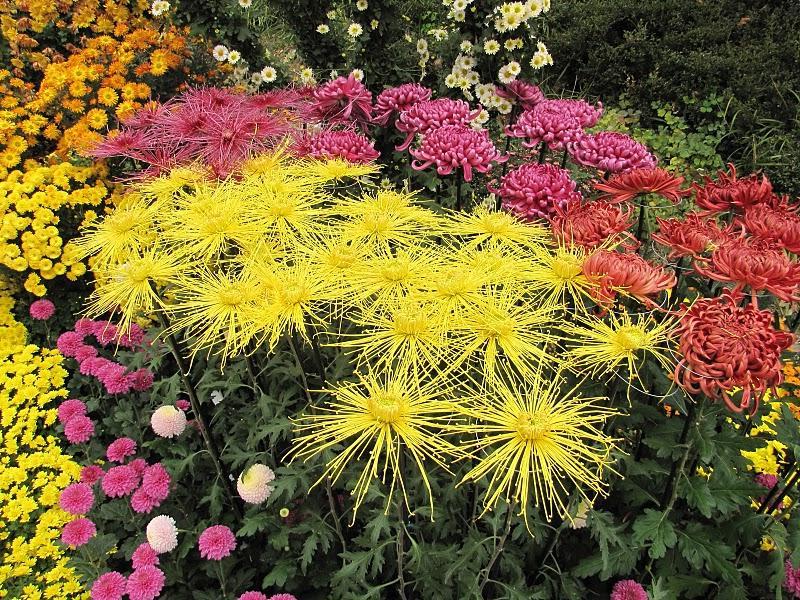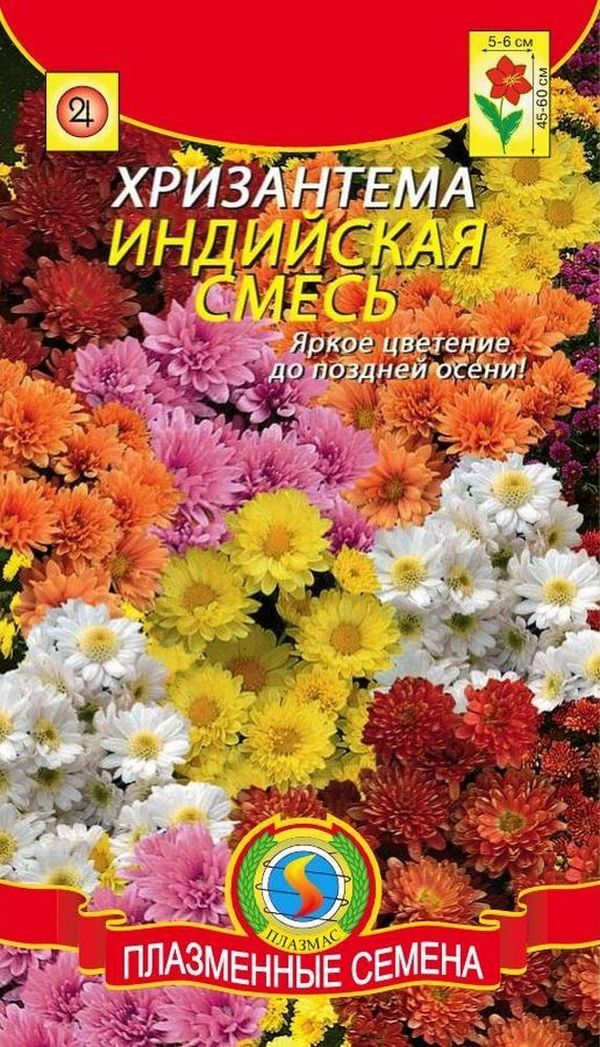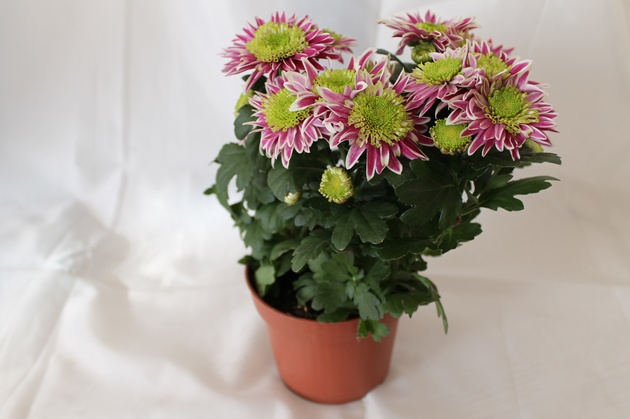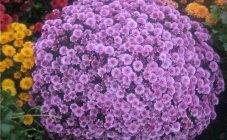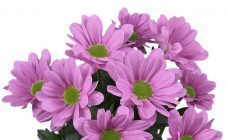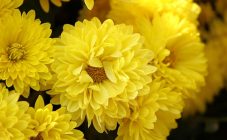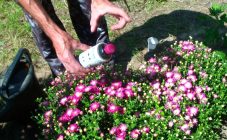Content:
Translated from Greek, the word "chrysanthemum" means "golden flower". In total, more than 10 thousand varieties of this species are known, each of which has its own unique characteristics (shape, color, size, etc.). The cultivation of these flowers began in China more than 2000 years ago. In Europe, chrysanthemum gained popularity in the 17th century, and after 100 years they began to engage in artificial cultivation.
Chrysanthemum Indian, or Indian mixture, is a perennial plant that belongs to the Asteraceae (Asteraceae) family. The species has a surprisingly long flowering period (1-2 months without losing its attractiveness), which begins in the fall, when summer colors gradually fade. This quality makes chrysanthemums even more valuable.
Flower features
Flowers of this species have long earned special authority, for example, a chrysanthemum is depicted on the obverse of a Chinese 1 yuan coin. The image of this plant is often found in works of art and music. Also, handmade chrysanthemums are made on the basis of living plants, which are very popular with customers. Many varieties, including Indian chrysanthemum, serve as ingredients (in the form of flower petals) for the preparation of medicines. Some plant species can also be eaten.
They contain substances such as:
- vitamin A;
- glycoside;
- choline;
- adenine;
- essential oil;
- eufualacon.
Chrysanthemum flowers are used to make tea, which awakens the appetite. Essential oil has a beneficial effect on the brain, which is very useful in Parkinson's disease. An infusion made from chrysanthemum flowers has a powerful antipyretic effect. Compresses based on flower leaves will help eliminate migraine attacks.
Species characteristics
In nature, this type of chrysanthemum is found in the Caucasus, the Middle East and India. Culture is much less common in European countries.
Indian chrysanthemum is distinguished by its hardiness, drought resistance and winter hardiness. The plant does not tolerate shade, as it belongs to the number of light-loving crops.
The golden flower is actively used in landscape design. Beautiful Indian chrysanthemum will look great on any flower bed, in flower beds. Several varieties of this species can be grown in one place. In this case, the composition will look brighter and more distinctive. The main thing in a floral ensemble is harmony and a sense of proportion.
The maximum stem height is 1.5 m, with the average value varying from 80 to 100 cm. The stems branch, the leaves are dissected. The flowering period is in August-November or September-December. This or that variety depends on the characteristics of the climate. The seeds ripen by December.
The flowers are composed of many small petals of a golden yellow color (there are other color options) and resemble a basket in shape. The bud is present on each branch of the chrysanthemum, which makes the bush look especially beautiful during intense flowering.
Indian chrysanthemum varieties
Among the most famous varieties of Indian chrysanthemum, the following are distinguished:
- Anastasia... Flowers can be of different colors: from white, pink and yellow to lilac, green and lemon. Flat terry inflorescences reach 17 cm in diameter. The petals resemble rays in appearance. The inflorescence itself is located at the top of a sturdy stem 17 cm long. The variety got its name in honor of Princess Anastasia, daughter of Nicholas II.
- Aurora... Flat terry inflorescences are colored orange. The upper side of the flowers is red, the lower one is yellow. The diameter of the latter is 7-10 cm. The height of the chrysanthemum reaches 1 m. Strong shoots are few.
- Snowy elf... Terry flowers, white, 5-8 cm in diameter. Plant height 50-70 cm.
- Carnival... Differs in a variety of color palette and a long flowering period.
- Tziya... The flowers are maroon, petals with a white border. Bushes are low, flowers are medium in size.
- Artist... Stripes of white and pink stretch along the petals.
- North Bye... The main feature is the yellow-white petals with a purple stripe.
- Like Worth... The flowers look like chamomile. This variety is very unusual and therefore has a great decorative value. Yellow stripes run along the edges of the orange petals gathered around the green center.
- Altgold... It is characterized by a flat inflorescence of bright yellow color and a low stem. Blooms from August to October.
- Vimini... Outwardly it looks like a sunflower. Flowers can be yellow, lemon, orange. The core of the flower is brown. Differs in a short flowering period.
- Cleopatra... Blooms profusely over time. The flowers are bright, sunny shades. The variety has a compact bush shape.
All these and other varieties of Indian chrysanthemum are unique and magnificent in their own way. Most of them are the result of artificial selection.
Planting and leaving
It can be quite difficult to grow plants with large flowers on your own. However, if you follow the recommendations of experienced florists, it seems quite possible to breed all kinds of varieties of this type of chrysanthemum.
There are two ways to grow them:
- from seeds;
- by cuttings.
Growing varieties of chrysanthemum Indian seed mixture requires the following rules:
- Since many are interested in the question of whether the Indicum Mix chrysanthemum can grow in the open field, it is worth noting, yes, it can, however, only seedlings are planted in open ground.
- Before being placed in the soil, the seeds are wrapped in a damp cloth and stored in this form for several days. The temperature must be at least 5 ° C.
- Wet seeds are planted in the soil.
- The soil in the container must also be moist.
- Seed material is not covered with soil to ensure the penetration of sunlight.
- The boxes with the planted seeds are covered with foil, airing from time to time.
- As soon as they germinate, the film is removed, and the soil is loosened.
- Seedlings are placed in open ground after warm weather is established.
- Bushes should be spaced 50 cm apart.
- The soil requires regular loosening and watering.
- Flowers need full access to light.
- At the end of the flowering period, the stems are cut, leaving 10-20 cm. Then the plants are placed in containers with moistened sand and stored over the winter at a temperature of 2-5 ° C.
When growing Indian chrysanthemums by the second method, the following recommendations must be observed:
- The length of the cuttings must be at least 20 cm. In the spring they are rooted in the ground.
- Seedlings are covered with foil with the possibility of regular airing. At the same time, cellophane should not come into contact with the cuttings.
- As soon as the flowers sprout, the film is removed.
- The shoots should be fed with nitrogen-containing fertilizers.
Another method of propagation by cuttings is that the flowers are first germinated in pots until they are fully rooted, and only then are they planted in the ground and covered with foil.
Both at home and in the garden, caring for the chrysanthemum Mix involves regular watering, feeding, pruning and other necessary activities. The variety does not tolerate high temperatures. For normal growth and long-term flowering, the temperature must be maintained at 10-15 ° C. In summer, the pot with the plant is placed in a dark, well-ventilated place, and in winter it is stored at 5 ° C.
Chrysanthemum Mix does not tolerate direct sunlight, so it is best to place the flower near the eastern or western windows.
The plant loves moisture, so you need to water it once every 3 days. To prevent the flower from rotting, it should not be taken too much. It is allowed to moisten the soil with tap water, but before that it must be allowed to stand for 2 days. Chrysanthemum is periodically sprayed with clean water.
The first pruning is needed for the correct formation of the bush. To do this, pinch the chrysanthemum a couple of times, thereby stimulating the growth of side shoots. The tops are cut for the last time 2 weeks before flowering. The next pruning, in which all shoots are removed to a level of 10 cm, is carried out before placing the plant in a dark, dry, ventilated place for the winter.
Diseases and pests
Like any other plant, this species is affected by diseases and pests. Among the latter, the greatest threat is posed by:
- nematodes;
- spider mite (feed on plant cell sap);
- aphid.
Indian chrysanthemum is perfect for growing both beginners and experienced growers. Flowers embody original beauty and unique style. If you care for the plant competently, observing the recommendations listed in the article, the chrysanthemum will delight you with its lush and bright flowering for a long time.
